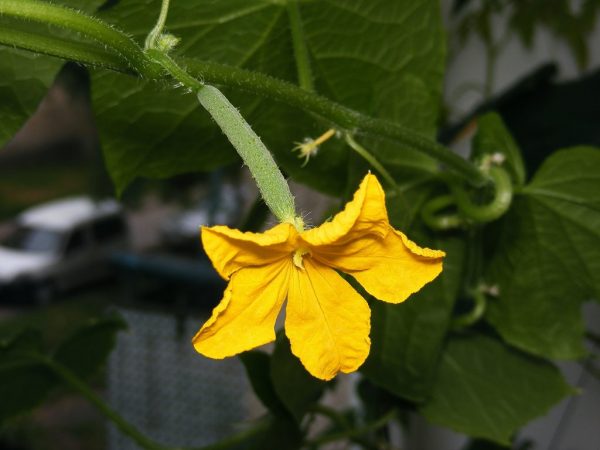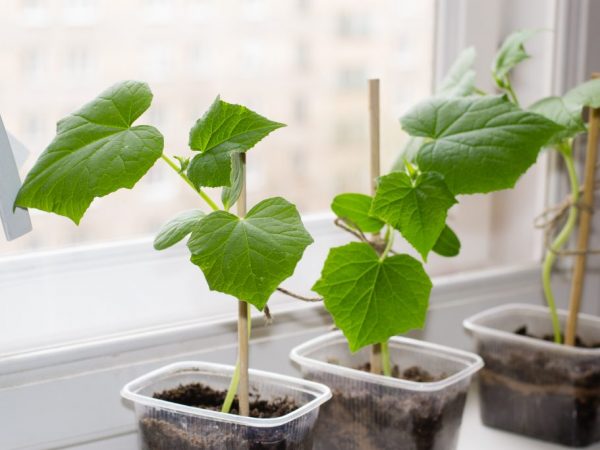Why can cucumbers turn yellow and dry on the windowsill
Cucumber is a capricious culture, so its cultivation in the country or at home on the window sometimes turns into a test. There are many reasons why cucumbers turn yellow and dry on the windowsill. The main problem is that the seedling embryos do not really have time to bloom or the grown plants begin to dry - this is insufficient or excessive lighting, improper feeding and watering.

Cucumbers turn yellow and dry on the windowsill
Causes of yellowing of cucumbers
Lighting
Cucumbers have a large number of broad leaves that shade the lower part of the plantings, so the seedlings may lack sunlight, especially in unnatural conditions, such as on a windowsill, where light comes from only one side. If the leaves begin to turn yellow and dry, the cucumbers need extra care and possibly extra lighting. Watch the planting for several days, if the leaves continue to dry, then move some of your seedlings to the east or south side of the house.
Watering
Cucumbers are a very demanding crop for watering. Moistening the soil should be done once a week, or better - every day. Insufficient irrigation leads to diseases of both seedlings and adult cucumbers. Cucumbers consume water especially abundantly when the fruits are tied and grow. You just need to establish an adequate irrigation schedule and take into account the experience of specialists, and then your plantings will not dry out.
Hypothermia
Most of the territory of Russia is a zone of risky farming, and the historical homeland of cucumbers is India. With sharp daily temperature fluctuations, if you have a window open at home or you grow cucumbers on the balcony, plantings may suffer, as some of the leaves die, and the rest turn pale. The most favorable regime for cucumbers is considered to be constantly warm air, without significant temperature jumps.
Food
For proper development, cucumber leaves require phosphorus, potassium and magnesium. The condition of the lower leaves of cucumbers is an indicator of their health, and the dying off of parts of the leaves may mean that the plantings have no longer had enough nutrients. From the very beginning of planting seeds in the ground, it is recommended to feed the cucumbers with complex dressings.
Fungal diseases
Cucumbers grow well in greenhouses, but strong watering and high humidity provoke the development of fungi and soil bacteria. In this case, infection of the cucumbers is possible. Gardeners who grow cucumbers without props and leave cucumber lashes lying on the ground may also face this problem. Usually, with this problem, treatment with an antiseptic intended for plants helps: Topaz or Quadris. The fungus is treated with trichodermine, basezol or phytosporin.Affected leaves should be removed and best burned, avoiding fungal contamination of other plantings.
End of the season
The yellowing and drying of the leaves can be due to the fact that cucumbers are annuals that dry up at the end of their life cycle after enough fruits and seeds have grown for the next season.
Bacterial yellowing of cucumbers
What if the yellowing of the leaves is caused by bacteria? In this case, such a folk remedy as a solution of lactic acid whey will help. You need to take two parts of this composition and ten parts of water and regularly treat plants with it. Lactic acid good bacteria will inhibit the development of bad bacteria without harming the plant itself.
Fertilization rate
Why do cucumber seedlings on the windowsill turn yellow and what should be done in this case? If you observe watering and maintain a favorable temperature for the seedlings of the selected variety, and it is not affected by fungi and bacteria, then the problem is a lack of fertilizers. Top dressing must be applied repeatedly, using both organic and mineral fertilizers. If the seedlings of all the cucumbers on the windowsill turn yellow, then this is the first indicator of an imbalance in the mineral and vitamin complex.
Organic fertilizers
One of the most common types of organic fertilizer that works well for feeding is mullein infusion. If cucumber leaves dry on a well-lit windowsill, then you can feed the plantings at the rate of 1 kg of manure per 3 liters of warm water. The components should be mixed and after the solution has settled, it is diluted with water again and the plants are watered. Manure can also be used at the summer cottage.
Thanks to manure and its positive and correct composition, it almost does not allow for overdose in the soil and on plantings, which cannot be said about artificial mineral fertilizers.
Manure

Manure is a good fertilizer.
- In dry form, it is applied in autumn or spring when fertilizing and loosening stagnant soil.
- A small top dressing with each watering can be provided to the plants by placing manure along the plantings.
- In the form of a liquid top dressing, the solution can be prepared in this case in a separate closed container, adding the required amount for watering.
Tops
Tops of plants are also considered a good fertilizer. Each gardener chooses how to use unnecessary plant parts removed during pruning. A few of the most common ways:
- Compost pit. Stems and leaves that have not yet dried are placed in a compost pit, where they decompose in humid conditions without access to air, turning in about a season into an excellent organic fertilizer. The finished fertilizer is applied by laying it under the beds.
- The tops of legumes, carrots or beets, as well as mustard, can be ground fresh, or applied dry, to the place where you plan to plant cucumbers or, for example, tomatoes.
- Waste tops, cut branches and weeds can be burned off, providing excellent fertilizer for many crops. At the same time, gardeners get rid of weed seeds, eggs and larvae of insect pests, as well as old foliage affected by bacteria and fungus.
- From unnecessary plant parts, you can make green fertilizer. In this case, the container is filled with green plant debris by about three-quarters or more, and filled to the brim with water. Then the resulting mass is left to ferment for a week and a half, covering the container with a lid or film. The advantage of green fertilization is that the plantings are fed immediately and are easily digested. Also, an alkaline solution lowers the acidity of the soil. The solution should be used in a ratio of 1:10 (1 liter of infusion per bucket).
Mineral fertilizers
Organic dressings still contain an insufficient amount of minerals, therefore, in addition to organic matter, you need to feed the cucumbers with the following fertilizers:
- Nitrogen.Most often, cucumber tops begin to dry out precisely because of the lack of nitrogen in the soil. Nitrogen is found in urea, ammonium nitrate and carbamide. But care should be taken: with an excess of nitrogen, the foliage becomes thick and acquires a rich dark green color, but the number of ovaries decreases sharply. If this happens, the matter can be improved by simply regularly watering your plantings - in this case, nitrogen is washed out of the soil.
- Phosphorus. If the leaves turn yellow due to a lack of phosphorus, then its replenishment is slightly more difficult than in the previous case. Since the formation of the root system directly depends on the supply of this element and with a lack of it, cucumbers begin to starve: growth slows down, ovaries stop forming, and the yield falls accordingly. In this case, it is worth adding superphosphate to the soil, but you should be careful: excess phosphorus prevents plants from assimilating potassium, therefore it is necessary to apply fertilizers in a complex manner and observing the dosage.
- Potassium. The lack of potassium is determined by such signs as: a change in the color of the leaves to bright green, they often dry out at the edges; lashes grow abundantly, but excessively, become too thin; almost no ovaries are formed, even if the plant is in greenhouse conditions; the fruits are too watery, may be bitter. Potassium is involved in the delivery of nutrients to all parts of cucumbers, and also affects the immune system, so you should not allow a deficiency or excess of this element.
What to do if barrel cucumbers turn yellow
Many gardeners grow cucumbers in barrels right on the windowsill. It happens as follows: in advance, it is possible in the garden, in the barrel throughout the season they put the tops of weeds and cut grass, and next spring add earth, humus and mineral fertilizers. The seeds can be planted in mini barrels filled with nutritious soil and grown on a windowsill. Cucumbers planted in this land develop well, as they receive a full set of essential nutrients - organic and mineral fertilizers.
But sometimes when growing, many gardeners are concerned about the question of why the leaves of cucumbers on the windowsill, which are grown in barrels, turn yellow? Most often this happens because the conditions for growing cucumbers in barrels are not met. If the barrel is metal, then you need to do so that the edges of the barrel are covered, otherwise the lashes can burn themselves on the heated metal - this is the most common cause of yellowing and burning of plant leaves.
Cucumber lashes can hang loosely from the edges of the barrel or cling to installed grates, which makes it easier to pick the fruit and makes it difficult for fungus or soil bacteria to infest, which can easily happen when growing cucumbers without garters. It is advised to install the barrel on the sunny side, but make sure that it does not overheat and that the plantings do not get burned.
Useful tips for gardeners
If you notice that the leaves of all the cucumbers on the windowsill turn yellow, then immediately proceed to clarify the problem. Many diseases of cucumbers can be solved in the early stages of the disease, without the use of chemicals. Collecting fruits grown independently on the window should be carried out only after the cucumbers are fully ripe. Vegetables from your own garden, even if the perimeter of your growing area is limited by the size of the windowsill, retain much more nutrients, ensuring the body's health and longevity.
Self-grown fresh produce differs from store bought in taste and quality. If you still doubt whether it is worth growing cucumbers at home on the window, then the answer is of course it is. If you follow the regime of fertilizing, watering and lighting, then even an inexperienced gardener will be able to grow a bountiful and healthy harvest of cucumbers in his window.


